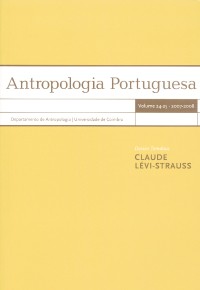Please use this identifier to cite or link to this item:
https://hdl.handle.net/10316.2/28865| Title: | Sinais de fogo: análise antropológica de restos ósseos cremados do Neolítico final/Calcolítico do tholos OP2b (Olival da Pega, Reguengos de Monsaraz) | Authors: | Silva, Filipa Cortesão Cunha, Eugénia Gonçalves, Victor |
Keywords: | Cremated bone;anthropological analysis;collective burial;Late Neolithic/Chalcolithic;tholos OP2b;Portugal;Restos ósseos cremados;análise antropológica;sepultura colectiva;Neolítico final/Calcolítico;tholos OP2b;Portugal | Issue Date: | 2008 | Publisher: | CIAS - Centro de Investigação em Antropologia e Saúde | Abstract: | From the remains recovered on the tholos OP2b excavation, located in
Olival da Pega, in Reguengos de Monsaraz district, and Late Neolithic/Chalcolithic
chronology, were studied 5404 segments of cremated bone, 5365 of these human.
These bone pieces were studied in order to obtain anthropological information
regarding paleodemography, paleopathology and taphonomy. The applied methods
were based on a macroscopic observation and the use of a magnifying glass whenever
necessary. identified and documented segments were not complete and exhibited low levels of
preservation. The sample includes the bone remains of 16 individuals, nine adults
and seven non adults of different ages, and the sexual diagnosis identified four
females and two males. Signs of degenerative, metabolic and traumatic pathology
were also found. Different levels of combustion, especially bone segments burned
in low temperatures of approximately 285ºC, and individuals cremated in different
stages of decomposition resulted from fire signals interpretation. The minimum
number of individuals per type of bone indicates a primary deposition.
This analysis provides a series of data that will certainly contribute to the knowledge
of the profile of the individuals placed in this megalithic monument and the
understanding of some aspects of the Prehistory. Do espólio recuperado na escavação do tholos OP2b, localizado em Olival da Pega, no concelho de Reguengos de Monsaraz, e de cronologia Neolítico final/ Calcolítico, foram estudadas 5404 peças ósseas cremadas, 5365 das quais humanas, com vista a obter informações antropológicas de índole paleodemográfica, paleopatológica e tafonómica. O método utilizado consistiu na observação macroscópica recorrendo, quando necessário, à lupa. Verificou-se que, dos 1927 elementos identificados e inventariados, 91,75% não estavam completos e apresentavam teores de preservação muito baixos. Restos ósseos de, pelo menos, 16 indivíduos, nomeadamente, nove adultos e sete não adultos de distintos grupos etários integravam a amostra, tendo a diagnose sexual revelado quatro sujeitos do sexo feminino e dois masculinos. Foram, também, detectados indícios de patologia degenerativa, metabólica e traumática. Diferentes graus de combustão, sobretudo peças ósseas alvo de temperaturas baixas da ordem dos 285ºC, e indivíduos cremados em diferentes fases de decomposição decorrem da interpretação dos “sinais de fogo”. Já a frequência do número mínimo de indivíduos por tipo de osso indicia a prática de deposição primária. A presente análise faculta uma série de dados que, certamente, irão contribuir para o conhecimento do perfil dos indivíduos depositados neste monumento megalítico, clarificando também alguns aspectos da Pré-história. |
URI: | https://hdl.handle.net/10316.2/28865 | ISSN: | 2182-7982 | DOI: | 10.14195/2182-7982_25_7 | Rights: | open access |
| Appears in Collections: | Antropologia Portuguesa |
Files in This Item:
| File | Description | Size | Format | |
|---|---|---|---|---|
| ap24-25_artigo8.pdf | 5.6 MB | Adobe PDF |  |
Items in DSpace are protected by copyright, with all rights reserved, unless otherwise indicated.
